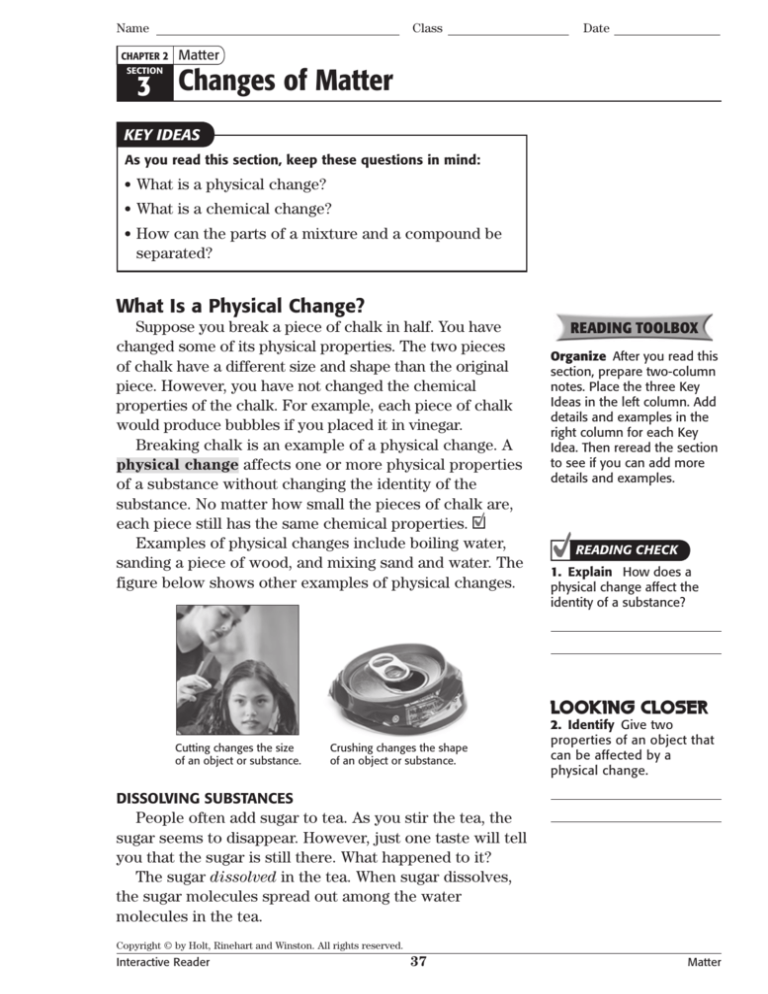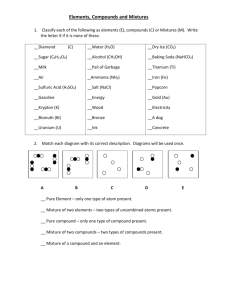
Name
CHAPTER 2
Class
Date
Matter
SECTION
3 Changes of Matter
KEY IDEAS
As you read this section, keep these questions in mind:
• What is a physical change?
• What is a chemical change?
• How can the parts of a mixture and a compound be
separated?
What Is a Physical Change?
Suppose you break a piece of chalk in half. You have
changed some of its physical properties. The two pieces
of chalk have a different size and shape than the original
piece. However, you have not changed the chemical
properties of the chalk. For example, each piece of chalk
would produce bubbles if you placed it in vinegar.
Breaking chalk is an example of a physical change. A
physical change affects one or more physical properties
of a substance without changing the identity of the
substance. No matter how small the pieces of chalk are,
each piece still has the same chemical properties.
Examples of physical changes include boiling water,
sanding a piece of wood, and mixing sand and water. The
figure below shows other examples of physical changes.
READING TOOLBOX
Organize After you read this
section, prepare two-column
notes. Place the three Key
Ideas in the left column. Add
details and examples in the
right column for each Key
Idea. Then reread the section
to see if you can add more
details and examples.
READING CHECK
1. Explain How does a
physical change affect the
identity of a substance?
EHHDBG@<EHL>K
Cutting changes the size
of an object or substance.
Crushing changes the shape
of an object or substance.
2. Identify Give two
properties of an object that
can be affected by a
physical change.
DISSOLVING SUBSTANCES
People often add sugar to tea. As you stir the tea, the
sugar seems to disappear. However, just one taste will tell
you that the sugar is still there. What happened to it?
The sugar dissolved in the tea. When sugar dissolves,
the sugar molecules spread out among the water
molecules in the tea.
Copyright © by Holt, Rinehart and Winston. All rights reserved.
Interactive Reader
37
Matter
Name
SECTION 3
Class
Date
Changes of Matter continued
Water molecules attract the
sugar molecules and pull
them apart. As a result, the
sugar molecules spread out,
or dissolve, in the water.
LOOKING CLOSER
3. Analyze Do the
molecules of water and sugar
change as sugar dissolves?
Water
molecule
Sugar
molecule
Dissolved sugar
molecule
When sugar dissolves in water or tea, the molecules
do not change. In other words, the components of the
mixture keep their identities. Because no atoms recombine when one substance dissolves in another, dissolving
is a physical change.
MELTING AND FREEZING
Melting and freezing are also examples of physical
changes. Consider what happens when a gold nugget is
melted to form a gold ring. The gold changes from solid
to liquid and then back to solid again. The shape of the
gold also changes, but the atoms of gold do not change.
Critical Thinking
4. Infer Why is melting a
physical change and not a
chemical change?
One way to form
gold rings is to melt
the gold and then
pour it into a mold.
Gold nugget
Molten gold
Gold rings
Copyright © by Holt, Rinehart and Winston. All rights reserved.
Interactive Reader
037-042_SP_C02_MAT_S03.indd 38
38
Matter
4/5/07 1:00:14 PM
Name
SECTION 3
Class
Date
Changes of Matter continued
What Is a Chemical Change?
Some materials are useful because they can change
and combine to form new substances. For example,
gasoline is flammable. When it burns, it produces CO2
and H2O and releases a great deal of energy. Because of
this property, people use gasoline to power machines.
Burning compounds is an example of a chemical
change. A chemical change happens when one or
more substances change into new substances that
have different properties.
Chemical changes take place constantly both around
you and inside you. For example, chemical changes occur
when fruits ripen and when leaves change color. The
oxygen we breathe undergoes several chemical changes
inside your body. These chemical changes supply the
energy your body needs.
READING CHECK
5. Describe What happens
during a chemical change?
REARRANGEMENT OF ATOMS
Recall that atoms are not rearranged during a physical
change. During a chemical change, however, atoms
re-arrange to form new substances. For example, when
you bake bread, you combine water, flour, and yeast.
Each ingredient has its own properties. The heat of the
oven and interactions among the ingredients cause
chemical changes. These changes produce a new
substance—bread.
8g^i^XVa I]^c`^c\
6. Compare How does a
chemical change differ from
a physical change?
EVIDENCE OF CHEMICAL CHANGE
Certain clues can tell you that a chemical change has
happened. These may include:
• Production of gas bubbles
• Change in color or odor
• Release of light, sound, or heat
The Statue of
Liberty is made
of copper.
Copper is a
shiny, orangebrown metal.
However, when
copper reacts
with water and
compounds in
the air, green
compounds
form.
When you add
effervescent
tablets to water,
a chemical
reaction takes
place. The citric
acid and baking
soda in the
tablets react to
form carbon
dioxide. This
causes bubbles
to form.
EHHDBG@<EHL>K
7. Identify What two clues
that a chemical change has
happened are shown in this
figure?
Copyright © by Holt, Rinehart and Winston. All rights reserved.
Interactive Reader
39
Matter
Name
SECTION 3
Class
Date
Changes of Matter continued
REVERSING CHEMICAL CHANGES
READING CHECK
8. Explain How can a chemical change be reversed?
READING CHECK
9. Identify What kind of
change is used to separate
components of a mixture?
Most chemical changes that you observe in your daily
life cannot be reversed. For example, bread baking, milk
turning sour, and iron rusting are examples of chemical
changes that cannot be reversed. However, under the
right conditions, some chemical changes can be reversed
by another chemical change. To reverse a chemical
change, the atoms in the new substance must recombine
again.
How Can a Mixture Be Separated?
Recall that a mixture is a combination of substances
that are not chemically combined. Each component of a
mixture has the same chemical identity that it had before
the mixture was made. Therefore, separating a mixture
does not involve recombining atoms. In other words, the
components of a mixture can be separated by physical
changes.
Some mixtures can be separated easily. For example,
pizza is a mixture that has components you can see. If
you don’t like one of the toppings on a pizza, you can
take it off. Removing a component of a mixture is a
physical change.
Other mixtures are more difficult to separate. For
example, you cannot pick salt out of saltwater. However,
you can separate the components of saltwater by heating
the mixture. When the water evaporates, the salt remains.
Sea water is a mixture.
Its components can be
separated by physical
changes. In a saltwater
pond such as this one,
sea water evaporates
and salt is left behind.
KXcb8Yflk@k
Find Examples With a
partner, think of some types
of mixtures that could be
separated with each of these
methods: evaporation, distillation, filtration, by centrifuge. Discuss whether each
method would be better for
separating mixtures of solids,
mixtures of liquids, or
mixtures of both.
Some other methods of separating mixtures are
described below:
• During distillation, a mixture is heated and each
component boils and evaporates at a different time.
• In filtration, a liquid component passes through a
filter and solid components stay in or on the filter.
• Spinning some mixtures in a centrifuge causes
components to separate.
Copyright © by Holt, Rinehart and Winston. All rights reserved.
Interactive Reader
40
Matter
Name
SECTION 3
Class
Date
Changes of Matter continued
A centrifuge is
used to separate
substances that
have different
densities. The
centrifuge spins
rapidly and denser
substances collect
at the bottom of
the tube.
EHHDBG@<EHL>K
10. Identify What property
of a substance is important
for separating a mixture with
a centrifuge?
How Can a Compound Be Separated?
Recall that a compound is made up of atoms that are
chemically combined. As a result, a compound can be
broken apart only by rearranging atoms. In other words,
the elements that make up a compound can be separated
only by chemical changes. For example, when the
compound mercury (II) oxide is heated, it breaks down
into the elements mercury and oxygen.
READING CHECK
11. Identify What kind of
change is needed to separate
a compound—physical or
chemical?
A compound,
such as mercury
(II) oxide, can be
separated into
elements only by
chemical changes.
Some compounds can be separated with electrical
currents. For example, scientists can pass current
through table salt when the compound is in a liquid state.
This causes the compound to separate into its elements—
sodium and chlorine.
Some compounds undergo chemical changes to form
simpler compounds. Gasoline in a car engine reacts with
oxygen to produce carbon dioxide and water. Additional
changes can break down carbon dioxide and water into
the elements carbon, oxygen, and hydrogen.
Copyright © by Holt, Rinehart and Winston. All rights reserved.
Interactive Reader
41
Matter
Name
Class
Date
Section 3 Review
SECTION VOCABULARY
chemical change a change that occurs when
one or more substances change into entirely
new substances with different properties
physical change a change of matter from one
form to another without a change in chemical
properties
1. Classify For each example, place a mark in the correct column to indicate
whether it is a physical change or a chemical change.
Example
Chemical change
Physical change
Ice cream melting
Fruit rotting
Paint peeling
An egg frying
Plants changing carbon dioxide and
water into sugar and oxygen
Salt dissolving in water
2. Infer Can a physical change reverse a chemical change? Explain your answer.
3. Compare How do the general methods for separating mixtures and compounds
differ?
4. Apply Concepts Suppose your teacher asks you to separate a mixture of sand and
water. Which of the following methods would you use: distillation, filtration, or
evaporation? Explain your answer.
5. Compare Does a physical change affect the identity of a substance? Does a chem-
ical change affect the identity of a substance?
Copyright © by Holt, Rinehart and Winston. All rights reserved.
Interactive Reader
42
Matter









